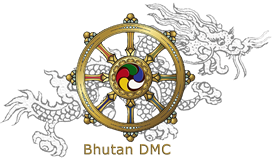Mongar (altitude 1620m) – A hilltop town with sweeping view of surrounding mountainous landscape and green valleys
Situated on a hill side overlooking the Kuri chhu river valley and surrounding villages, Mongar town is 450km east of Bhutan’s capital city, Thimphu. The second largest town in the sub-tropical east, Mongar like Trashigang further east, is situated on the side of a hill in the contrasts to other towns of Western Bhutan which are located on the valley floor. The district is enclaved by Trashigang, Lhuentse, Pema Gatshel, Samdrup jongkhar, Zhemgang & Bumthang districts and Kuri chhu, Sheri chhu & Dangme chhu are important rivers in the district. Its lower and the southern parts are sub-tropical while northern and the higher regions have temperate climatic conditions. Summer can be hot and humid while winter remains cold.
Places of Interest in Mongar
Mongar Dzong
The most celebrated site in Mongar is the Dzong itself (fortress) built in 1930s. Yet the Dzong is built in the same method and traditions of all the other Dzongs; no drawings and nails have been used. A visit provides visitors an impression of how traditional Bhutanese architecture has continued to thrive through the centuries.
Drametse Lhakhang
Drametse Lhakhang is one of the largest and most important monasteries in eastern Bhutan, founded in 16th century by a highly accomplished Ani (Nun) named Choten Zangmo, the granddaughter of the famous religious master, Terton Pema Lingpa. The temple is deeply associated with Terton Pema Lingpa and the Peling tradition of Buddhism. It houses wide range of spiritual treasures & other sacred objects and is the source of spiritual inspiration to the people of Drametse and neighbouring communities.
Drametse Ngacham or the ‘Dance of the Drums of Drametse,’ is the best-known dance of all, composed in the 16th century at in this temple, by a saint who had a vision of Guru Rinpoche’s heaven. The Twelve men wearing yellow skirts and animal masks beat drums as they dance; they represent Guru Rinpoche’s entourage while they are celebrating the victory of religion. This dance brings, liberation to those who see it. Drametse Ngacham dance was also proclaimed as a ‘Masterpiece of the World Intangible Heritage’ by UNESCO in 2005.
The temple is located about 1.5-hour drive from Mongar-Trashigang highway. Though the road is narrow and strewn with pebbles, its every bend on uphill ascend offers fascianting view of valleys and distant mountains. One can also get excellent views of Udzorong village of Trashigang, on this drive.
Yakang Lhakhang
Situated next to the town in a small village, Yakang Lhakhang is a sacred shrine in Mongar, built by Sangdag, the youngest son of Terton Pema Lingpa. Its architectural pattern is in sync with other traditional Bhutanese buildings and this two-storied temple plays an important role in religious life of the people of the region.
Ruins of Zhongar Dzong
The ruin of Zhongar Dzong is a testimony to the skill of Bhutanese builders, most notably the renowned master craftsman, Zowo Balip. This site is on a hilltop overlooking the village of Thridangbi and is visible as one descends to Lingmethang from the highway. Built in the 17th century, the Dzong is believed to have been built at a site where the master architect Zow Balip saw a white bowl. A visit to the ruins can be a memorable experience and gives one a sense of the medieval Bhutanese administration.
HOTELS IN THIMPHU
HOTELS IN PUNAKHA & WANGDUE
HOTELS IN GANGTEY
HOTELS IN TRONGSA
HOTELS IN BUMTHANG
HOTELS IN MONGAR
HOTELS IN TRASHIGANG
HOTELS IN SAMDRUP JONGKHAR
HOTELS IN PHUENTSHOLING
HOTELS IN HAA
HOTELS IN GELEPHU
HOTELS IN ZHEMGANG
RESTAURANTS IN PARO
RESTAURANTS IN THIMPHU
RESTAURANTS IN PUNAKHA
TOUR ITINERARIES
TREKKING ITINERARIES
SPECIAL INTERESTS TOURS
UNIQUE FESTIVALS & FAIRS
BLOG


